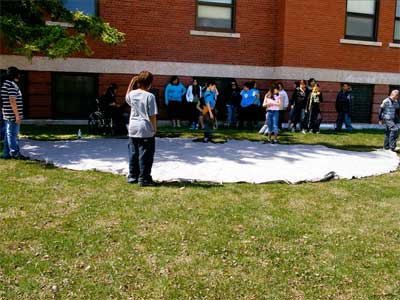| |||
| Math Central | Quandaries & Queries |
|
Question from Lacy: Hi there! We are building a tipi for our children. We want to build a large one about 15ft tall with a base of about 15 feet diameter. I am trying to figure out how much canvas we need to accomplish this. I graduated about 20 years ago and am struggling. Please help if you can. |
Hi Lacy,
Most of the tipis I have seen, like the one in the diagram below, have the canvas in the shape of almost a perfect half circle.

Diagram from a tipi raising with elder Glen Anaquod.
I am going to assume you are going to work with a semicircle and then use the formulas that I have in a response to an earlier question. Since the canvas is in the shape of a semicircle $D = 180$ degrees. $H$ is the height of the tipi. $R$ is the radius of the circle at the bottom of the tipi and $P$ is the radius of the semicircle of canvas. ($P$ is also the slant height of the tipi. See the diagrams in this earlier response.)
Since $D = \large \frac{R}{P}$ and $D= 180$ we have that $P = 2 R,$ or $R = \large \frac{P}{2}.$ The other equation is $P = \sqrt{R^2 + H^2}$ and hence $P = \sqrt{\left( \large \frac{P}{2}\right)^2 + H^2}$ or $P^2 = \left( \large \frac{P}{2}\right)^2 + H^2 .$ Hence $P = \large \frac{2}{\sqrt{3}} H.$
You want $H$ to be 15 feet and hence this gives $P = \large \frac{2}{\sqrt{3}} \times 15 = 17.32$ feet. Since $P = 2 R$ this is also the diameter of the base of the tipi.
To make this tipi then you need a semicircle of canvas of radius 17.32 feet.
The base of the tipi is slightly larger than you wanted so let me know if this is not suitable,
Penny
 |
||
Math Central is supported by the University of Regina and The Pacific Institute for the Mathematical Sciences.